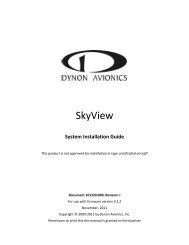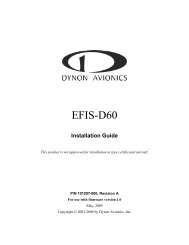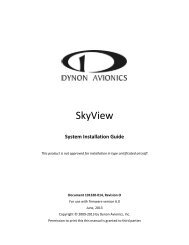EFIS-D100 Installation Guide - Dynon Avionics
EFIS-D100 Installation Guide - Dynon Avionics
EFIS-D100 Installation Guide - Dynon Avionics
Create successful ePaper yourself
Turn your PDF publications into a flip-book with our unique Google optimized e-Paper software.
Appendix<br />
Appendix B: <strong>Dynon</strong> OAT Probe <strong>Installation</strong> and Usage<br />
Note that this section only applies to the OAT with 3 wires (colored red, yellow, and blue), for<br />
connection to the EDC-D10A. If you have the 2-wire OAT (with black/white wires), see one of<br />
the EMS-based <strong>Installation</strong> <strong>Guide</strong>s for more information.<br />
The following instructions provide information on installing and using the <strong>EFIS</strong>-<strong>D100</strong> OAT<br />
probe. Keep in mind that this probe is designed specifically to work with the <strong>EFIS</strong>-<strong>D100</strong>. Do not<br />
expect it to work properly with another OAT or TAS/Density Altitude system. If you own an<br />
<strong>Dynon</strong> EMS product with an OAT installed, your <strong>EFIS</strong>-<strong>D100</strong> can receive its OAT value from<br />
the EMS via the DSAB wires. See the <strong>Dynon</strong> Smart <strong>Avionics</strong> Bus (DSAB) Wiring section on<br />
page 3-11 for information on connecting the two instruments.<br />
TOOLS AND MATERIALS REQUIRED<br />
<br />
<br />
<br />
<br />
<br />
<br />
<strong>Dynon</strong> <strong>Avionics</strong> OAT probe/cable with nylon nut and washer.<br />
Drill with 3/8” bit<br />
<strong>Dynon</strong> <strong>Avionics</strong> EDC-D10A remote compass module.<br />
2 machined D-sub pins<br />
D-sub pin crimp tool<br />
Loctite<br />
INSTALLATION<br />
Mount Location<br />
It is important that the OAT probe be mounted somewhere on the skin of the aircraft where it<br />
will not be affected by heat sources (sun, engine, aircraft interior, etc). The ideal location would<br />
receive no heat from the aircraft engine or any other source in the aircraft body. While this may<br />
be impractical, it is a good idea to mount the probe as far away from heat sources as possible. On<br />
the RV series, common locations include the wingtip and under the horizontal stabilizer. Avoid<br />
these three locations:<br />
Engine exhaust paths<br />
The engine itself<br />
Where the sensor will have direct sunlight<br />
Where the backside is exposed to a heated cabin<br />
Mounting Instructions<br />
After the mounting location has been determined, drill a 3/8” hole in the skin at the desired<br />
location. Uncoil the cable attached to the OAT probe. Remove the nylon nut from the cable.<br />
From outside the skin of the aircraft, insert the cable first and then the threaded end of the OAT<br />
probe. From within the skin of the aircraft, gently pull the cable until the threaded end of the<br />
OAT probe pokes through the hole. Thread the nylon nut down the cable and up to the threaded<br />
end of the OAT probe. Spread some Loctite around the threads of the OAT probe. Twist the nut<br />
onto the threads of the OAT probe and tighten.<br />
<strong>EFIS</strong>-<strong>D100</strong> <strong>Installation</strong> <strong>Guide</strong> 7-7
















